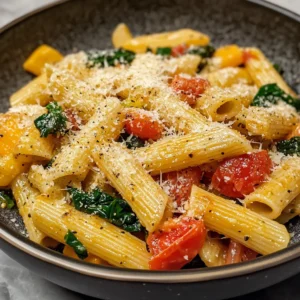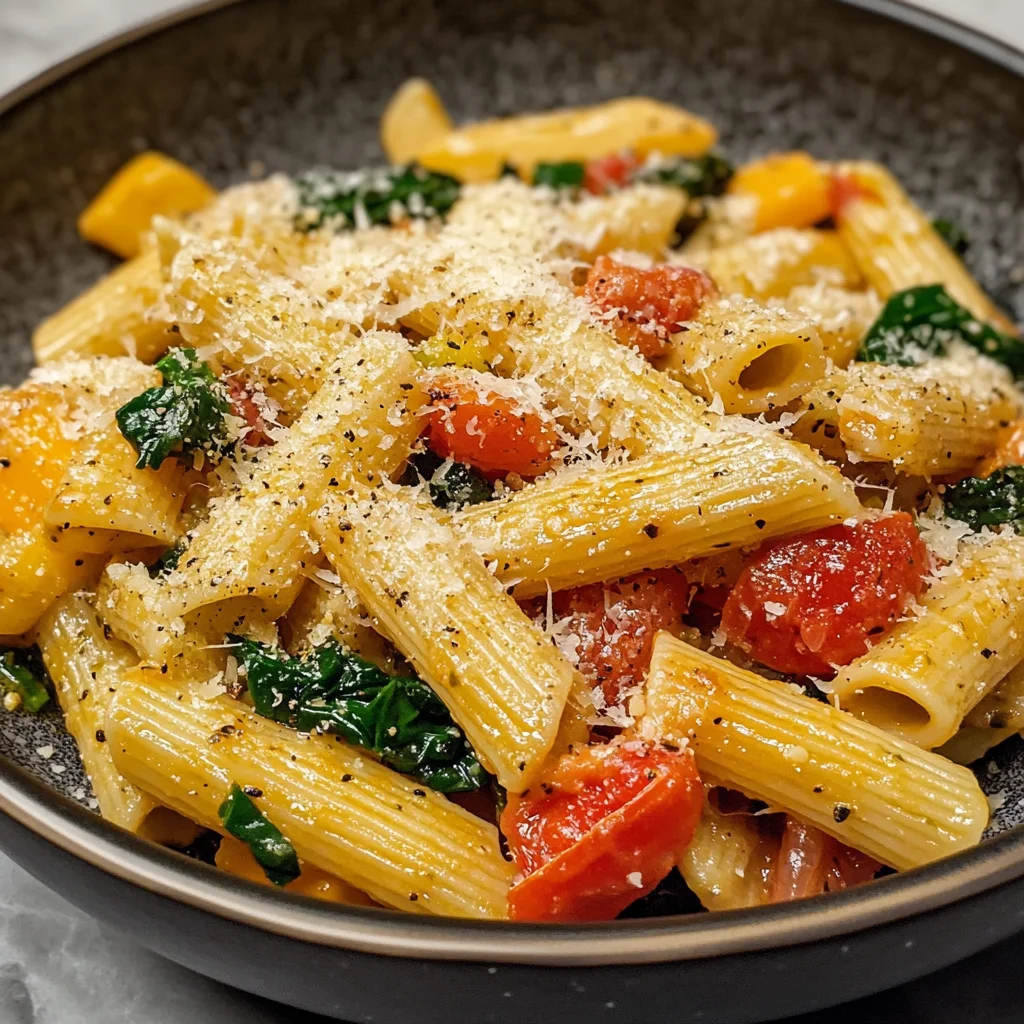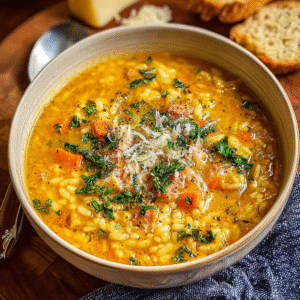Pasta Primavera, meaning “spring pasta” in Italian, is more than just a dish; it’s a celebration of fresh, seasonal vegetables bursting with flavor. This vibrant pasta dish is a testament to the simple beauty of letting fresh ingredients shine. Forget heavy sauces and complicated techniques; Pasta Primavera is all about showcasing the natural sweetness and textures of spring’s bounty. From the tender snap of asparagus to the juicy sweetness of peas, every bite is a delightful explosion of spring flavors. This recipe is a perfect weeknight meal, effortlessly elegant enough for a dinner party, yet simple enough for a busy weeknight. Whether you’re a seasoned cook or a kitchen novice, this recipe is guaranteed to impress. Get ready to experience the sunshine on your plate with this unforgettable Pasta Primavera recipe.
Why You’ll Love This Pasta Primavera Recipe
This Pasta Primavera recipe isn’t just another pasta dish; it’s a culinary experience. Here’s why you’ll adore it:
- Unbelievably Fresh and Flavorful: The star of the show is the abundance of fresh, seasonal vegetables. We’re talking vibrant colors, crisp textures, and a symphony of tastes that will awaken your senses. Each bite is a burst of spring’s freshest offerings.
- Incredibly Easy to Make: This recipe is designed for simplicity. No complicated techniques or obscure ingredients are needed. Even a beginner cook can master this recipe in under 30 minutes. It’s the perfect solution for a quick and delicious weeknight meal.
- Highly Customizable: Pasta Primavera is a blank canvas for your culinary creativity. Feel free to swap out vegetables based on your preferences and what’s in season. Add some sun-dried tomatoes for a tangy twist, or throw in some artichoke hearts for a richer flavor profile. The possibilities are endless!
- Naturally Healthy and Nutritious: Loaded with vitamins, minerals, and fiber from the fresh vegetables, this Pasta Primavera is a guilt-free indulgence. It’s a light yet satisfying meal that nourishes your body while delighting your taste buds.
- Beautiful Presentation: The vibrant colors of the vegetables make this dish a feast for the eyes as much as it is for the palate. It’s a visually stunning pasta that’s perfect for impressing guests or simply brightening your own dinner table.
Why You Should Try This Pasta Primavera Recipe
Beyond its deliciousness, this Pasta Primavera recipe offers several compelling reasons to give it a try:
- Perfect for Beginners: The straightforward instructions and readily available ingredients make it ideal for novice cooks. Mastering this recipe builds confidence in the kitchen and opens the door to exploring more complex dishes.
- A Great Way to Use Seasonal Produce: This recipe champions seasonal eating, encouraging you to utilize the freshest, most flavorful vegetables available. It’s a sustainable and delicious approach to cooking.
- A Healthy and Balanced Meal: This dish provides a balanced intake of carbohydrates, proteins, and vitamins, making it a nutritious and satisfying meal option for the whole family. It’s a fantastic way to incorporate more vegetables into your diet.
- Versatile and Adaptable: Customize this Pasta Primavera to suit your dietary needs and preferences. Adapt it for vegan, vegetarian, or gluten-free diets by making simple substitutions, as outlined in the Tips and Variations section.
- A Flavorful and Satisfying Dish: The harmonious blend of flavors and textures provides a truly satisfying culinary experience. It’s a dish that will leave you feeling nourished and content, without the heaviness of a rich, creamy sauce.
Ingredients and Utensils for Your Pasta Primavera
Gathering the right ingredients and utensils ensures a smooth and successful Pasta Primavera cooking experience. Let’s get started!
Ingredients:
- 1 pound pasta (linguine, fettuccine, or your preferred shape): Choose a pasta that can hold the sauce well. Consider gluten-free pasta for dietary needs.
- 1 pound asparagus, trimmed and cut into 1-inch pieces: Look for bright green asparagus spears with firm tips.
- 1 cup broccoli florets: Choose firm, bright green broccoli florets.
- 1 cup snow peas, trimmed: Look for vibrant green snow peas with no blemishes.
- 1 red bell pepper, thinly sliced: Choose a bell pepper that is firm and vibrant in color.
- 1 yellow bell pepper, thinly sliced: Again, choose a firm and vibrant bell pepper.
- 1/2 cup cherry tomatoes, halved: Choose ripe, juicy cherry tomatoes.
- 1/4 cup grated Parmesan cheese: Use freshly grated Parmesan cheese for the best flavor.
- 2 cloves garlic, minced: Freshly minced garlic adds a pungent and aromatic touch.
- 1/4 cup olive oil: Use extra virgin olive oil for the best flavor and health benefits.
- Salt and freshly ground black pepper to taste: Seasoning is crucial for enhancing the flavors of the vegetables.
- Optional: 1/4 cup chopped fresh basil: Basil adds a fresh, herbaceous note. Other herbs like parsley or chives can also be used.
- Optional: Red pepper flakes for a touch of heat: A pinch of red pepper flakes adds a subtle spicy kick.
Utensils:
- Large pot for boiling pasta: A large pot is essential for ensuring the pasta cooks evenly.
- Colander for draining pasta: Use a colander that is large enough to accommodate your pasta.
- Large skillet or wok for sautéing vegetables: A large pan provides ample space for sautéing all the vegetables without overcrowding.
- Cutting board: Choose a sturdy cutting board to prevent slipping and injury.
- Sharp knife: A sharp knife makes chopping vegetables much easier and safer.
- Wooden spoon or spatula for stirring: A wooden spoon or spatula is ideal for stirring the vegetables without scratching the pan.
- Measuring cups and spoons: These are crucial for precise measurements.
- Serving bowl or platter: Use a bowl or platter that is large enough to hold the pasta and vegetables.
- Grater for Parmesan cheese: A grater ensures that you get finely grated Parmesan cheese.
Detailed Recipe Steps for the Perfect Pasta Primavera
Follow these steps to create a delightful Pasta Primavera:
- Boil the pasta: Bring a large pot of salted water to a rolling boil. Add the pasta and cook according to package directions until al dente. **Remember to reserve about 1/2 cup of pasta water before draining.** This starchy water will help to create a creamy sauce.
- Sauté the vegetables: While the pasta is cooking, heat the olive oil in a large skillet over medium heat. Add the garlic and cook for about 30 seconds until fragrant. **Do not burn the garlic!** Add the asparagus, broccoli, and bell peppers. Sauté for 5-7 minutes, until the vegetables are tender-crisp. **Stir occasionally to ensure even cooking.**
- Add the remaining vegetables: Add the snow peas and cherry tomatoes to the skillet. Cook for another 2-3 minutes, until the snow peas are bright green and tender. **Don’t overcook the vegetables, as they should retain some of their crispness.**
- Combine pasta and vegetables: Add the drained pasta to the skillet with the vegetables. Toss to combine. **If the sauce seems too dry, add a little bit of the reserved pasta water at a time until you reach your desired consistency.**
- Season and serve: Stir in the Parmesan cheese, salt, pepper, and any optional herbs or red pepper flakes. Toss everything together until well combined. Serve immediately. Garnish with fresh basil if desired.
Tips and Variations for Your Pasta Primavera
Here are some tips and variations to make your Pasta Primavera even better:
- Vegetable Substitutions: Feel free to substitute vegetables based on your preferences and what’s in season. Zucchini, mushrooms, carrots, green beans, or artichoke hearts are all excellent additions. Check out OviaRecipes for more seasonal vegetable combinations.
- Protein Additions: For a heartier meal, add grilled chicken, shrimp, or tofu to your Pasta Primavera. Cook the protein separately and add it to the pasta at the end.
- Vegan Adaptation: Omit the Parmesan cheese and use nutritional yeast for a cheesy flavor. Ensure your pasta is vegan-friendly.
- Gluten-Free Adaptation: Use gluten-free pasta to make this dish suitable for those with gluten intolerance. Ensure all other ingredients are also gluten-free.
- Creamy Variation: For a creamier sauce, stir in a dollop of cream cheese or crème fraîche at the end.
- Lemon Zest: A little lemon zest can add a bright, refreshing touch to your Pasta Primavera.
- Avoiding Common Mistakes: Don’t overcook the vegetables, as they should retain some of their crispness. Make sure you reserve some pasta water to adjust the consistency of the sauce. And don’t forget to season generously!
Nutritional Values and Health Benefits of Pasta Primavera
Pasta Primavera is not just delicious; it’s a nutritional powerhouse. A single serving (approximately 1.5 cups) provides a good source of:
- Vitamins: Rich in vitamins A, C, and K from the various vegetables, contributing to immune function, vision health, and blood clotting.
- Minerals: Contains potassium, magnesium, and iron, essential for healthy blood pressure, muscle function, and oxygen transport.
- Fiber: Provides fiber from the vegetables and potentially the whole wheat pasta, promoting healthy digestion and gut health.
- Antioxidants: The colorful vegetables are packed with antioxidants, helping to protect cells from damage.
- Protein: Provides a moderate amount of protein, especially if you add protein sources like chicken or tofu.
Approximate Nutritional Information (per serving, values may vary based on ingredients used):
- Calories: 400-500
- Protein: 15-20g
- Fat: 15-20g
- Carbohydrates: 50-60g
Note: This is an estimate and can vary depending on the specific ingredients and quantities used.
Frequently Asked Questions (FAQ) about Pasta Primavera
Here are some answers to common questions about making Pasta Primavera:
- Can I prepare the vegetables ahead of time? Yes, you can chop the vegetables a day in advance and store them in an airtight container in the refrigerator.
- What if I don’t have all the vegetables listed? No problem! Pasta Primavera is highly customizable. Use whatever vegetables you have on hand or what’s in season.
- Can I add other herbs besides basil? Absolutely! Parsley, chives, oregano, or thyme would all be delicious additions.
- What type of pasta is best for Pasta Primavera? Linguine, fettuccine, or rotini are all great choices. Choose a pasta that holds the sauce well.
- How can I make the sauce creamier? Add a dollop of cream cheese, crème fraîche, or a little bit of pasta water to create a creamier sauce.
- Can I make this dish ahead of time? It’s best to serve Pasta Primavera fresh, but you can prepare the vegetables and cook the pasta ahead of time. Combine them just before serving to prevent the vegetables from becoming soggy.
- What if my vegetables are getting too soft? Reduce the heat and cook for a shorter time. The vegetables should be tender-crisp, not mushy.
Conclusion: Embrace the Spring with Your Delicious Pasta Primavera
This Pasta Primavera recipe is a delightful celebration of spring’s bounty. Its simplicity, fresh flavors, and versatility make it a perfect meal for any occasion. From weeknight dinners to special gatherings, this vibrant pasta dish is sure to impress. Remember to customize it to your preferences – experiment with different vegetables, proteins, and herbs to create your signature Pasta Primavera masterpiece. Don’t forget to share your culinary creations with us in the comments below, and let us know how you enjoyed this recipe. Happy cooking, and bon appétit! Learn more about the history of pasta on Wikipedia.

Pasta Primavera with Lemon-Garlic Sauce
Equipment
- Large Pot
- Large skillet
- Colander
Ingredients
Main Ingredients
- 1 pound Pasta (penne, rotini, or your favorite)
- 1 bunch Asparagus Trimmed and cut into 1-inch pieces
- 1 cup Broccoli florets
- 1 pint Cherry tomatoes Halved
- 1 medium Zucchini Diced
- 3 cloves Garlic Minced
- 2 tablespoons Olive oil
- 2 tablespoons Lemon juice Freshly squeezed
- 1/2 cup Parmesan cheese Grated
- To taste Salt and pepper
Instructions
Instructions
- Cook pasta according to package directions until al dente. Drain and set aside.
- While pasta cooks, heat olive oil in a large skillet over medium heat. Add minced garlic and cook for 1 minute, until fragrant.
- Add asparagus, broccoli, and zucchini to the skillet. Cook for 5-7 minutes, until vegetables are tender-crisp.
- Stir in cherry tomatoes and cook for another 2-3 minutes.
- Add cooked pasta to the skillet and toss to combine with the vegetables.
- Stir in lemon juice, salt, and pepper. Toss well to coat the pasta.
- Serve immediately, topped with grated Parmesan cheese.



